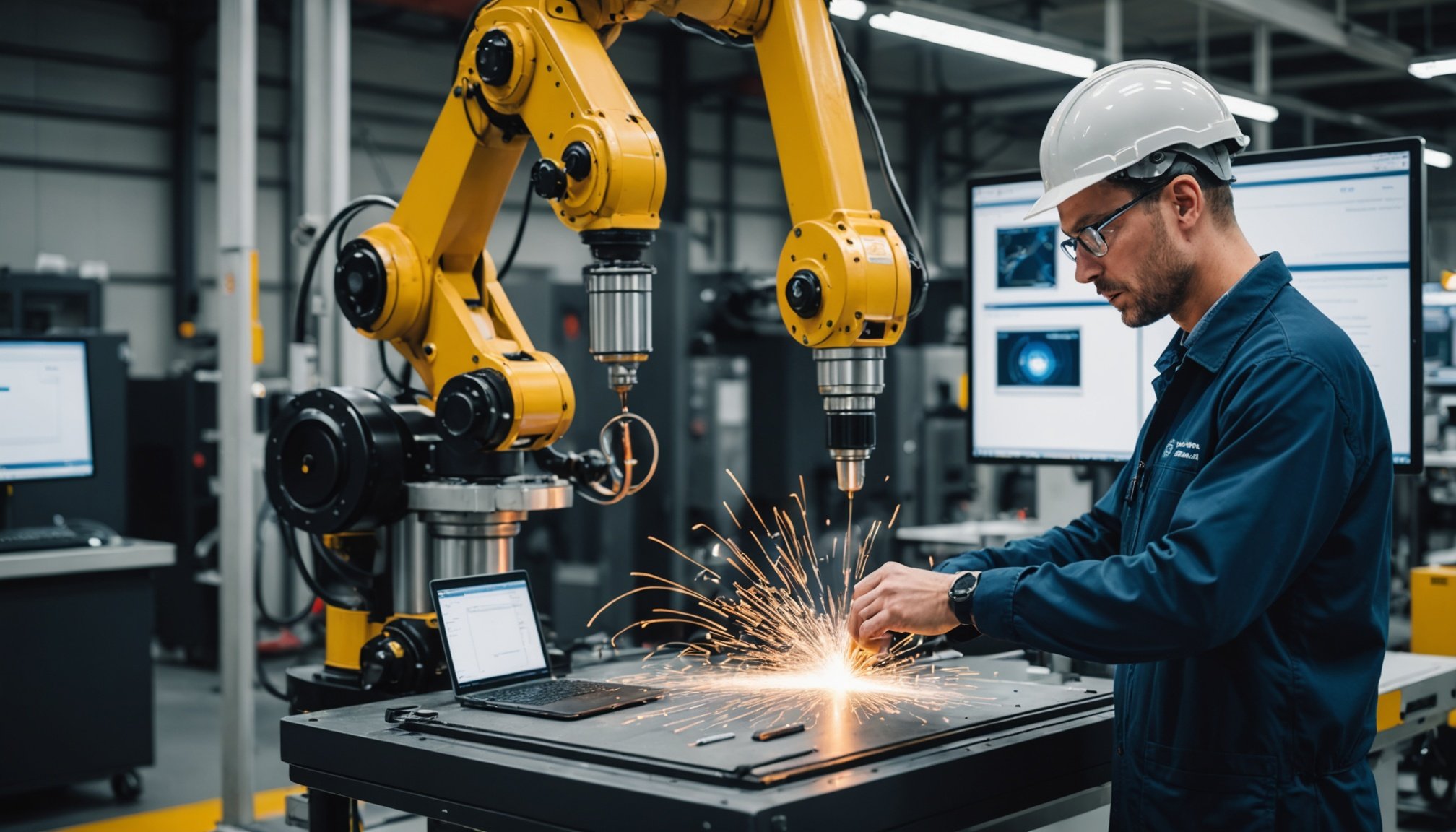Understanding AI-driven Predictive Maintenance
AI-driven predictive maintenance has revolutionized intelligent manufacturing by leveraging advanced technology to anticipate equipment failures before they occur. This proactive strategy is not just about averting mechanical breakdowns; it is about enhancing productivity and efficiency across the board.
By integrating AI tools, manufacturing companies can optimize their maintenance processes. These tools analyze data from various machine sensors to predict when a piece of equipment will require maintenance. Instead of adhering to a traditional, time-based maintenance schedule, companies can now undertake repairs based on actual machine condition, significantly reducing downtime and maintenance costs.
Have you seen this : Mastering precision: proven techniques to elevate ai-driven financial forecasting models
The key metrics for assessing productivity enhancement through AI predictive maintenance include decreased unplanned downtime, improved machine efficiency, and reduced maintenance expenditure. For example, manufacturers can track maintenance frequency over time to see how AI has streamlined workflow. Furthermore, by analyzing these metrics, organizations can pinpoint precisely where they are achieving the most significant savings and productivity gains.
Remarkably, AI also enables intelligent manufacturing to adapt more swiftly to changing demands. As machines are monitored continuously, adjustments can be dynamically made, allowing for more flexible production processes. In turn, this maximizes productivity while meeting the ever-evolving needs of the market.
Also to discover : Mastering ccpa compliance: a comprehensive roadmap for crafting your next web application
Tactics for Implementing AI in Predictive Maintenance
Implementing AI in predictive maintenance involves structured tactics aimed at enhancing manufacturing efficiency. It begins with data collection and analysis to create a foundation for effective maintenance solutions.
Data Collection and Analysis
The first step toward efficient AI implementation is gathering data from disparate sources like machines, sensors, and operational systems. This comprehensive data collection allows the crafting of intelligent systems capable of recognizing patterns and predicting potential failures.
Machine Learning Algorithms
Choosing the right machine learning algorithms is crucial for predictive analysis. These algorithms process collected data and assist in identifying trends or anomalies that could indicate equipment malfunctions. Selecting suitable algorithms tailored to specific manufacturing environments amplifies AI’s role in maintaining system reliability and reducing downtime.
Real-time Monitoring Systems
Real-time monitoring systems are essential as they provide timely insights into equipment conditions. These systems utilize collected data to deliver up-to-the-minute updates on machine performance, allowing proactive interventions before problems escalate. Integrating these systems ensures that any potential issues are addressed immediately, bolstering manufacturing efficiency.
Collectively, these tactics create a synchronized approach to using AI for upkeeping machinery and processes in manufacturing. Each component, from data analysis to real-time monitoring, plays a pivotal role in fostering a reliable and efficient operational environment. Intelligent systems designed through these strategies are transformative, reducing errors and enhancing productivity.
Benefits of AI-driven Predictive Maintenance
The benefits of predictive maintenance extend beyond immediate operational gains. A primary advantage is the significant cost savings achieved by reducing both unplanned downtime and the frequency of maintenance activities. By anticipating equipment failures and scheduling repairs accordingly, businesses can avoid costly emergency repairs and production halts.
Predictive maintenance also contributes to increased equipment lifespan and reliability. By addressing potential issues before they develop into major problems, machinery operates under optimal conditions, thus extending its usable life. This proactive approach ensures that equipment not only lasts longer but also functions reliably, minimizing disruptions in operations.
Furthermore, the integration of AI and big data analytics enhances operational efficiency by providing actionable insights through the examination of vast amounts of data. This leads to improved decision-making, as managers access real-time data and precise forecasts, enabling them to strategize effectively. Data-driven insights help in identifying efficiency bottlenecks, optimizing resource allocation, and planning maintenance schedules, ultimately fostering a more streamlined operation.
In summary, AI-driven predictive maintenance not only reduces costs but also elevates the overall efficiency and reliability of operations, offering a comprehensive solution that enhances business outcomes. It represents a forward-looking strategy that turns maintenance into a strategic advantage through technology-driven foresight.
Challenges in Adopting AI for Predictive Maintenance
Transitioning to AI-driven solutions for predictive maintenance presents several notable challenges that industries must tackle to ensure successful implementation.
Integration with Existing Systems
One of the prominent challenges in AI implementation is the seamless integration with existing systems. Industries often rely on legacy systems that may not be compatible with advanced AI technologies. This compatibility issue requires significant investment in both time and resources to update or even replace outdated systems. Moreover, integrating AI can disrupt current operations, necessitating careful planning and execution to minimise production downtime.
Skills Gap in the Workforce
Another barrier to the adoption of AI is the skills gap in the workforce. There is a pressing need for skilled professionals who can manage and operate sophisticated AI systems. Companies must invest in the training and upskilling of their current employees to bridge this gap. Providing education and continuous learning opportunities can help ease the transition and empower staff to adapt to the new technological landscape.
Data Privacy and Security Concerns
Data privacy and security are critical concerns when implementing AI in predictive maintenance. Organisations must navigate complex regulations to protect sensitive data from breaches. Ensuring compliance with these regulations and establishing robust security measures is essential to build trust and mitigate risks associated with data handling. Protecting privacy while leveraging AI capabilities is a delicate balance that companies must achieve to succeed.
Case Studies of Successful AI Implementation
In the world of manufacturing, AI implementation has demonstrated its transformative potential through various real-world applications. A noteworthy success story involves a leading manufacturer that integrated AI technology into its maintenance processes. By leveraging AI for predictive maintenance, the company effectively reduced unexpected downtime and streamlined operations.
This application highlights how predictive algorithms can analyze machinery data to foresee potential failures. As a result, it significantly improved equipment reliability and overall production efficiency. The metrics were compelling—with downtime reduced by 20% and maintenance costs cut by over 15%. Such data underscores the practical benefits of AI in enhancing operational performance.
However, these impressive results did not come without challenges. The company had to reassess its data infrastructure and ensure robust data collection systems were in place. Moreover, training employees on the new system was a critical step. These lessons learned emphasize the importance of preparation and workforce adaptation in successful AI adoption.
From this case study, it is clear that while AI offers powerful tools for maintenance improvement, its effective deployment requires careful planning, infrastructure readiness, and workforce engagement. This holistic approach can maximize the benefits and ensure sustainable success in AI implementations.
Tools and Technologies Supporting AI-driven Maintenance
In the dynamic world of AI-driven maintenance, predictive maintenance tools are key for preemptively addressing equipment issues. The integration of AI technologies enhances these tools, ensuring more precise predictions and minimising downtime. Let’s delve into the specific elements that structure this advanced maintenance landscape.
Software Platforms
Robust software platforms serve as the backbone of predictive maintenance. These platforms utilise machine learning algorithms to analyse data patterns, predicting equipment failures before they occur. Popular platforms often feature dashboards for monitoring equipment health, offering real-time insights through an intuitive interface. Additionally, the integration of cloud computing capabilities ensures scalability and remote access, empowering organisations to manage maintenance tasks seamlessly.
IoT Devices for Data Gathering
IoT devices are instrumental in collecting comprehensive data necessary for predictive maintenance. They gather real-time data from machinery, including temperature, vibration, and pressure metrics. This data is transmitted to analytics platforms where AI processes it to forecast potential failures. By employing such devices, industries can enhance their data collection capabilities, ensuring data accuracy and relevance for more informed decision-making.
Analytics and Reporting Solutions
Effective analytics and reporting solutions convert raw data into actionable insights. These solutions employ advanced algorithms to process vast amounts of data, highlighting critical patterns and trends. As a result, organisations gain the ability to prioritise maintenance efforts based on real-time analytics, ensuring optimal allocation of resources and extending equipment lifespan.
Framework for Mastering Productivity in Intelligent Manufacturing
The productivity framework in intelligent manufacturing relies on a structured approach that prioritizes AI integration. Implementing a comprehensive strategy requires clear steps to create an effective AI-driven maintenance strategy. Begin by identifying key performance indicators (KPIs) that highlight critical areas for improvement. This will enable the monitoring of machinery health and efficiency in real-time, ensuring proactive maintenance. Incorporating advanced data analytics can predict potential failures and maintain operational continuity.
Continuous improvement cycles are vital in manufacturing. These cycles focus on perpetual refinement through feedback loops and performance evaluations. Regularly assess processes and technologies to adapt to changing demands and innovations. Use AI models to analyse data, uncover trends, and recommend process enhancements. This structured approach not only maximises efficiency but also minimises downtime.
Collaboration across departments is essential for success in this evolving environment. Encouraging open communication facilitates quick solutions and aligns departmental goals with organisational objectives. Establish cross-functional teams to oversee projects, enabling varied expertise to refine processes from different perspectives. This collective effort aids in implementing AI-driven solutions effectively.
Through such a structured approach, the path to mastering productivity in intelligent manufacturing is paved. These strategies promote resilience and allow manufacturers to stay competitive in a technologically advanced landscape.






